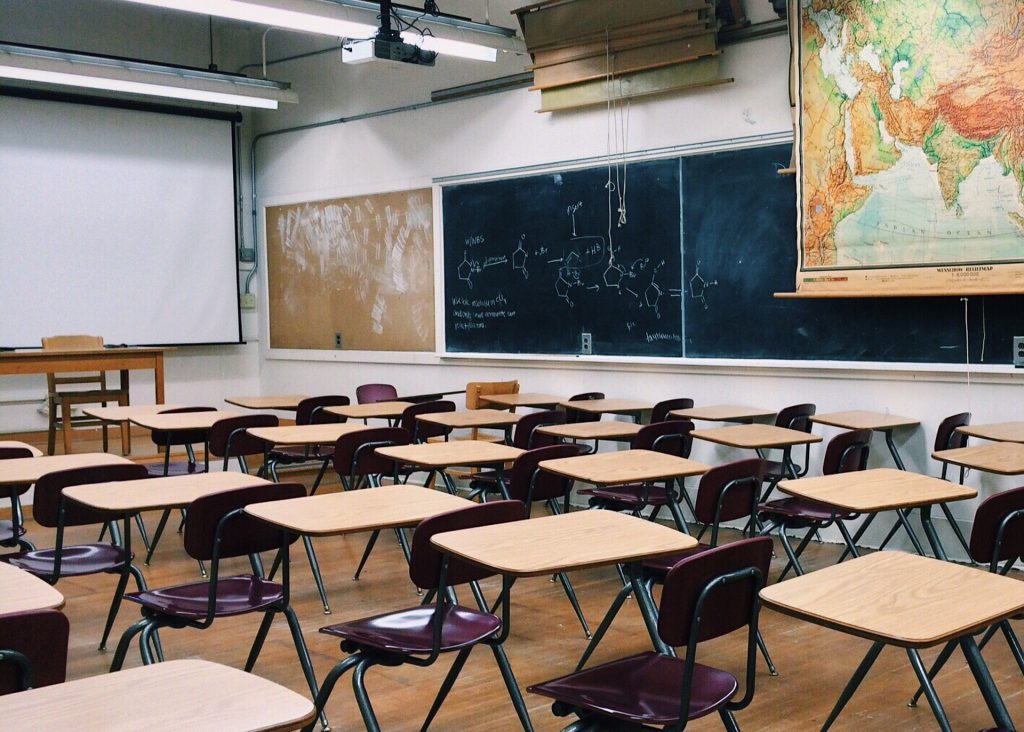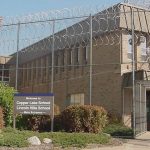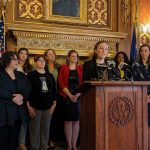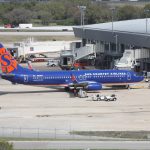Former Employees of Voucher School Discuss Safety Issues, ‘Third Friday’ Push
HOPE Christian School comes under scrutiny following gym injury.
HOPE Christian School Fortis promises a high-quality education for its “scholars,” most of whom use state-funded vouchers to attend. Its website features photos of joyful students and boasts of a “warm and nurturing community” and “dedicated teachers who are invested in your child’s learning” inside its classrooms.
After an accident in gym class in September, however, the school announced the campuses had “experienced several safety, behavioral and staffing concerns over the past week” and would be making some changes to address them. Those changes included hiring a new principal, combining two campuses into one and sending students home to do remote learning for a time.
The Milwaukee school did not specify the details of the concerns that led to the changes at the time, but three former employees of the school have told the Wisconsin Examiner that understaffing, too many students and inadequate support created an unsafe, unstable educational environment for students and staff at the school.
One Principal For Two Campuses
HOPE Christian School Fortis is one of six Wisconsin HOPE Christian Schools (the acronym stands for Hold Onto Promises Everywhere) run by Open Sky Education, a Wisconsin-based nonprofit that operates schools and educational programs in Wisconsin and Arizona. The other schools include HOPE Caritas, Fidelis, Prima, Semper and Via.
Five of the schools participate in the Milwaukee Parental Choice Program and one is part of the Racine Parental Choice Program. The Milwaukee program was first created in 1990 to offer private school vouchers to low-income students, with the idea that poor families deserve the same choices as wealthier families and that private schools could provide a better education to students who were struggling in high-poverty urban public schools. School vouchers expanded to Racine in 2011 and in 2013 the statewide Wisconsin Parental Choice Program was created. The number of students who receive private school vouchers in Wisconsin has grown from 350 students in the original Milwaukee program to almost 55,000 now enrolled in one of Wisconsin’s four voucher programs, including those in Milwaukee and Racine as well as the statewide program and the Special Needs Scholarship Program for children with disabilities. HOPE Christian School Fortis draws students through the Milwaukee parental choice programs.
HOPE Christian Schools started in 2002 after the Wisconsin Supreme Court ruling that allowed low-income students in Milwaukee to use a publicly funded school voucher to pay tuition at religious schools.
According to the Hope Christian Schools website, one of the founders of the school began asking, after the court decision, how Christians “could do more to serve urban children by providing them with excellent educational opportunities.” The answer was to build a network of schools that “offered rigorous academics, character formation, and faith formation accessible to the families qualifying for vouchers.”
The belief that private schools could provide a better educational environment for students and staff is part of what led Kristy to accept a job at the HOPE Christian School Fortis in Milwaukee teaching social studies and science in the 7th and 8th grades. (The Wisconsin Examiner is using only her first name because of her concern that her comments could affect her current employment.)
Kristy said everything looked “great on paper” when she accepted the job. She said she was under the impression there would be fewer behavioral issues and more of a focus on learning there than at a typical public school in Milwaukee.
“I feel like the parents are under the same impression as me, thinking that going to a private school, you’d have less of those behaviors and be able to teach more and have learning going on,” Kristy said. “But that’s not happening.”
Former staff at the school said that drastic understaffing and a lack of support for teachers resulted in a poor educational environment.
According to a former teacher, when teachers didn’t know where students were supposed to go or needed a break from their students, they would leave them unsupervised in the gym.
Schools across the U.S. have experienced staffing shortages in recent years, however, Kristy told the Wisconsin Examiner that the shortages at HOPE were so bad that she felt the school shouldn’t have opened. She noted that the school where she now teaches is still seeking to fill some staff positions, but, she adds, the school had a solid staff to begin with.
“The fact of the matter is they didn’t have anything in place to address these shortages,” Kristy said of the HOPE school where she worked. “They just shoved the kids in and said, ‘Do what we can.’”
Kristy started in August after a brief interview process and said her first hint that there were staffing problems was when she learned that the principal would be overseeing a school split across two campuses.
“I thought that was absolutely absurd,” Kristy said. “That’s impossible, especially with the number of kids, the needs of the kids, the low amount of staff, to have one principal for two schools is just madness.”
The school, which reported that 359 Milwaukee voucher students in kindergarten through eighth grade made up 100% of enrollment in mid-September, was split between the North campus at 3601 N. Port Washington Ave., and the South campus about half a mile away at 3215 N. Martin Luther King Jr. Dr.
On Sept. 14, a letter from Open Sky Education Chief Operating Officer Dan Depies informed parents about an accident involving a second-grade student on the school’s North campus. The student fell during mid-morning gym, according to the letter, and suffered a concussion. He was taken to the intensive care unit at Children’s Hospital in Milwaukee.
The letter about the accident outlined decisions that Open Sky Education said it would take to address “safety, behavioral and staffing concerns” after the incident.
“Trina Lockhart, former Principal, is no longer with HOPE Fortis, and Ms. Terri Ghee, Dean of Instruction, has stepped in as Interim School Leader,” Depies stated in the letter.
While the letter could give readers the impression that Lockhart’s dismissal was linked to the accident, in fact Ghee had already replaced Lockhart as the interim principal when the accident occurred. A spokesperson for the school says any impression that the incident was linked to Lockhart’s departure was unintentional. Lockhart says she was used as a “scapegoat.”
After accepting the job in July, Lockhart said she was told there was “a lot of housekeeping, house cleaning to do” at HOPE Christian Fortis. Her job involved overseeing both the North and South campuses and helping to address staffing shortages, which had started the prior year.
Lockhart said she spent many of her days interviewing candidates for teaching and teaching assistant positions and questioned why the school hadn’t made a more concerted effort to address the staffing shortage until after she was hired.
“If you knew there was a teacher shortage, you shouldn’t have waited until July 27 to start looking for teachers that you are going to put in a role and train by August 14. Why would you wait until I came on board to start doing any interviewing?” Lockhart said in an interview with Wisconsin Examiner.
‘Teachers Missing From Everywhere’
Lockhart said that the school had staff openings in most grade levels and had been employing teaching assistants to fill in as teachers since the previous year.
“We were in the highest need of teachers. We needed 13 teachers, meaning that we were in the red,” Lockhart said. “This is when I started really communicating that ‘Hey, you know, we don’t have teachers in our classrooms. It’s unfair expecting TAs to take on roles as teachers.’ For one, they are not qualified. For two, you don’t want to pay them any additional money.”
Lockhart noted that TAs came to her asking that they be paid more if they were expected to continue in teaching positions. She said she eventually got leaders of Open Sky Education to agree to pay the TAs an additional $5 per hour above their $15.53 hourly rate. It was still less than the $45,000 to $50,000 per year that Kristy says she and other teachers were making at the school.
Teachers at private schools participating in the Wisconsin Private School Choice Programs are required to have a DPI teaching license or at least a bachelor’s degree from an accredited institution, according to the state Department of Public Instruction (DPI). Teaching assistants at private choice schools need only to have graduated from high school or to have a general educational development (GED) or high school equivalency diploma.
Cidney Miller was hired at HOPE Christian School to serve as a teaching assistant for the sixth grade. She told the Wisconsin Examiner that she has worked in the education field for about nine years, including at multiple private choice schools in Milwaukee, but doesn’t have a college degree.
It was always something every day. … There’s a fight here. We have two kids, one of them has a dislocated arm. They’re suspending kids left and right. It’s because we don’t have any support. There’s no help in the classroom.
– Cidney Miller, HOPE Christian School teaching assistant
Miller said one week she was asked to sub for an eighth-grade teacher who was out sick with bronchitis, but that the teacher never returned.
“I actually ended up finishing the week subbing for her and after that week, they kind of figured that she wasn’t coming back,” Miller said.
Despite her lack of a college degree, Miller said she was put into a permanent teacher position. “I guess they assumed, because of the experience that I had, I was gonna be OK,” she said.
Miller said she didn’t feel prepared for the role, in part because she didn’t know how to plan lessons for the students, and that the work environment was in disarray.
Miller said that often teachers had to bounce around among grades or combine classes if a teacher was out sick.
“There were a few people that were around to help but it was really hard,” Miller said. “They were very, very short staffed. There were teachers missing from everywhere.”
‘Our All-Important Count Day’
Along with the shortages, the former staff members said they were overwhelmed by the number of students at the school.
“I mean, there was like, 35 kids jam-packed into this room,” Kristy recalls, adding that she had to find extra desks to seat additional students in her classroom.
According to screenshots of emails provided to the Examiner by Lockhart, Open Sky Education and HOPE Christian Schools leaders were working to enroll additional students in the weeks leading up to Third Friday — the day in September when public, charter and private choice schools across Wisconsin record their attendance counts to be sent to the state superintendent. Those counts are used to determine how much state money will be distributed to each school for the year.
In a Sept. 6 email, Open Sky COO Depies provided a “friendly reminder” to HOPE Christian Schools principals that the Fall Count Day deadline was in eight days and they needed to focus on processing student applications. He noted that they had received an additional 300 applications between Sept. 1 and Sept. 5.
In the same email, Depies acknowledged staffing concerns, writing, “I know several schools are short-staffed, if we need alternate plans (like short term temp), please contact me to discuss.”
A few days later, Depies sent another email with some notes about enrollment at the schools. The schools had increased their enrollment by 100 to 2,966 as of Sept. 8 — 90% of their 3,183 enrollment goal.
“We are excited to have Spirit week next week Sept. 11-15 to coincide with our all-important count day,” Depies wrote to close the email. “Let that JOY factor shine!”
State funding for schools in Wisconsin is tied directly to the enrollment count on one specific day. It’s a system that public school advocates have criticized for years, especially when it comes to the way private voucher schools, like HOPE, may use it. DPI does not keep data about transfers back to public school from private voucher schools. But public school advocates complain that students who are enrolled at private voucher schools for the Third Friday count can be expelled for any reason and return to public schools after that day, while the money allocated to the private voucher school for their education remains with the private school.
Depies said in a statement to the Wisconsin Examiner that HOPE Christian Fortis enrollment has been and remains at approximately 55-60% of total capacity and that the school waitlisted students to ensure that it could deliver “a high-quality education parents expect.”
Lockhart said, however, that while she was at the school there was an explicit emphasis on growing enrollment and it was the goal of the school admission manager to “secure as many applications and secure as many students as possible.”
Lockhart said administrators changed HOPE’s total enrollment goal a couple of times while she was principal. When she spoke initially with the school admissions manager, she said the goal was 456 students in part because of the staffing shortages. Later, however, that goal was increased to 526 students despite additional teachers not being hired.
“Why would you want 526 students and a growing number than the previous year if you know that you’re still not in a position to service them?” Lockhart said. She said she thought the enrollment goal was a result of the funding that the school was trying to secure.
Lockhart said she asked that caps be placed for certain grade levels, but her request was not heeded.
“I knew that I didn’t have any eighth grade teachers and they had already enrolled 40 eighth grade students,” Lockhart said. “I did ask that a cap be placed on eighth grade specifically because we didn’t have any teachers, and they didn’t agree with it, and the cap was lifted, [they] enrolled a few more.”
In most years, the school has reported an enrollment number of between 440 and 500 students according to DPI 3rd Friday counts from the 2016 to 2022 school years.
For the 2023-24 school year, HOPE Christian Fortis reported 345 full-time equivalent Milwaukee voucher students — a drop of about 103 students from the previous year when the school’s estimated payment was $3,767,791.40.
Its estimated payment from the state this year is $3,413,085.00.
The school mostly maintained its funding levels for the 2023-24 school year due to a recent funding boost given to choice private schools by the Republican-led state Legislature and Democratic Gov. Tony Evers.
Under 2023 Wisconsin Acts 11 and 19, state aid to private voucher schools for K-8 students was increased from $8,399 per pupil to $9,893 per pupil in the 2023-24 school year. It will rise again to $10,237 in the 2024-25 school year.
Milwaukee Teachers’ Education Association President Amy Mizialko said in a statement to the Wisconsin Examiner that the “system of third Friday counts has always been abused by private voucher and private charter schools that take money from public schools but that have little to no public scrutiny or accountability.”
“We are not surprised to hear these allegations in light of the fact the system incentivizes recruitment at the beginning of the school year yet does nothing to address the rampant abuse of that system,” Mizialko added.
“These allegations about Hope Christian – that they knew they had dangerously low staffing levels yet remained open through Third Friday in order to recruit and count as many students as possible – are much more serious,” Mizialko said. “If these allegations are true, not only should Hope Christian be held accountable by DPI, they should be held legally accountable.”
‘35-40 Kids In A Class’
The large number of students and lack of staff made it difficult for teachers and administrators at the school to handle student behavior.
Kristy said that during class she would sometimes try to show the students CNN 10 — a 10-minute news segment created to help students learn about current events and global issues — but it would often take her the entire period to get the class under control enough to accomplish that. She said it was impossible to get them to write or do other things.
“With that many students in one class with so many varying ability levels and so many different issues, it just … it doesn’t work,” Kristy said. “You can’t have 35-40 kids in a class.”
Like all schools, public and choice schools alike, we’ve been challenged by the realities of the significant teacher gaps in the workforce. We have joined with other school networks and community partners to identify ways to address these challenges.
– Open Sky Education COO Dan Depies
In comparison, according to the DPI Public Ratio of Students to FTE Staff Report, the Milwaukee School District in the 2022-23 school year had a ratio 13.78 students to every one licensed staff member. The ratio for students to aides, support and other employees was 20.25 students for every staff member.
DPI doesn’t collect data for private schools in the voucher program since schools in the parental choice programs, unlike regular public schools, are not required to report that data. The school did not respond to a question about how many teachers it currently employs by publication time. This story will be updated with any new information.
Kristy said that when teachers didn’t know where students were supposed to go or needed a break from their students, they would leave them unsupervised in the gym.
Miller, the TA, said fights would constantly break out in the gym as a result of the lack of supervision.
“It was just like, OK, are we not gonna just watch the kids…,” Miller said. “Those kinds of things kind of overwhelmed me, because … nobody’s really paying attention to see what’s going on or what’s really happening, and now we have to figure out how we’re going to explain to somebody’s mom about this.”
Miller left the school shortly after the announcement that the students would temporarily go to virtual learning. She left, she said, in part due to the lack of support for staff and student behavior. She said she “didn’t feel as if they were doing everything that needed to be done to ensure the success of these kids.
“It was always something every day. … There’s a fight here. We have two kids, one of them has a dislocated arm. They’re suspending kids left and right,” Miller said. “It’s because we don’t have any support. There’s no help in the classroom. A teacher can only teach, you can’t teach and discipline and do everything at one time. … Like I said, I’ve worked in a couple of schools and I’ve never been anywhere so chaotic.”
Changes Continue But So Does Lack of Oversight
Students returned to classrooms consolidated into one campus at the end of September. Open Sky Education would not make anyone from the organization or the HOPE Christian Fortis school available for an interview but provided a statement from Depies to the Wisconsin Examiner.
“HOPE Fortis continues to work hard to navigate a time of deep change for our school, always basing our decisions on what is best for our scholars, including combining our HOPE Fortis campuses earlier this year,” Depies said in the statement.
Depies said that the school has stabilized the learning environment in the last several months by focusing on staff training and filling open positions. He said the school has weekly and monthly action plans to continue making the necessary progress and recently completed an all-team-member survey and worked to enhance parent communication and student engagement opportunities.
“We are grateful for the continued strong partnership with our school families and the dedication of our staff,” Depies said. “Like all schools, public and choice schools alike, we’ve been challenged by the realities of the significant teacher gaps in the workforce. We have joined with other school networks and community partners to identify ways to address these challenges.”
Lockhart expressed her concern about the lack of oversight of schools like HOPE Christian, especially when it comes to treatment of staff members. She contrasted her experiences at choice schools with her time in Milwaukee Public Schools.
“When I left MPS in 2014, I secured a position with another [parental choice program] charter school and it was the same types of things — under-qualified people being promoted, TAs being in classrooms without licensing and not being paid for it, the treatment of the teachers,” Lockhart said. “All it did was make me think about the rights and the treatments that I had in [MPS]. There were certain guidelines that had to be followed … but with the charter and choice schools, you know, they take the at-will employment to an entirely different level.”
Kristy left in September because she said it was affecting her physically and mentally due to the unsafe environment. Reflecting on her time at HOPE Fortis, she said there were good teachers at the school who are putting in a good faith effort but that overall she doesn’t think that the best interests of the students were taken into consideration. She said that the situation at the school is likely part of “an epidemic amongst all of these kinds of places that pop up … they come to places where they see there’s a high need and then they just start taking taxpayer money.”
Kristy said that she was doubtful that the changes at the school were really fixing the issues.
“I think it’s running as what it is, a corporation,” Kristy said, “and I think that they’re looking at the dollar signs and that’s what’s most important to them.”
Former HOPE Christian School employees discuss concerns about staffing, safety was originally published by the Wisconsin Examiner.























It does seem odd that the people involved in the institutional racism in our current public school system are hell bent on making sure that no disadvantaged child of color has an educational option. No different than people in the south trying to keep schools segregated. Very sad
Brother Cotic has it exactly wrong…again; it’s the privateers who are miseducating children of color. These parents should sue.
Lack of oversight, unqualified, short staff, student injuries, a freaking mess
It does seem odd that the people involved in stealing money from public education are the same folks indoctrinating little kids with stories of demons, wizards, and polytheism claim absolute truth. Very rCon, RyCo.
Public schools have total disclosure over all aspects of their programs: salaries, expenditures, curriculum, etc. Choice schools intentionally do not have to report most all of the staffing data and financial information so that they can operate without any real public scrutiny. I am surprised that Dr. Howard Fuller, one of the major choice advocates in Milwaukee, has not said or done anything to promote accountability and quality in the choice schools and is comfortable with the existence of these marginally performing schools like Hope Christian. What good is choice in education if most of the choices are poorly functioning schools???
Why are public dollars going to private schools again exactly? Schools with zero oversight and can poach from public schools leaving only the most disadvantaged behind?